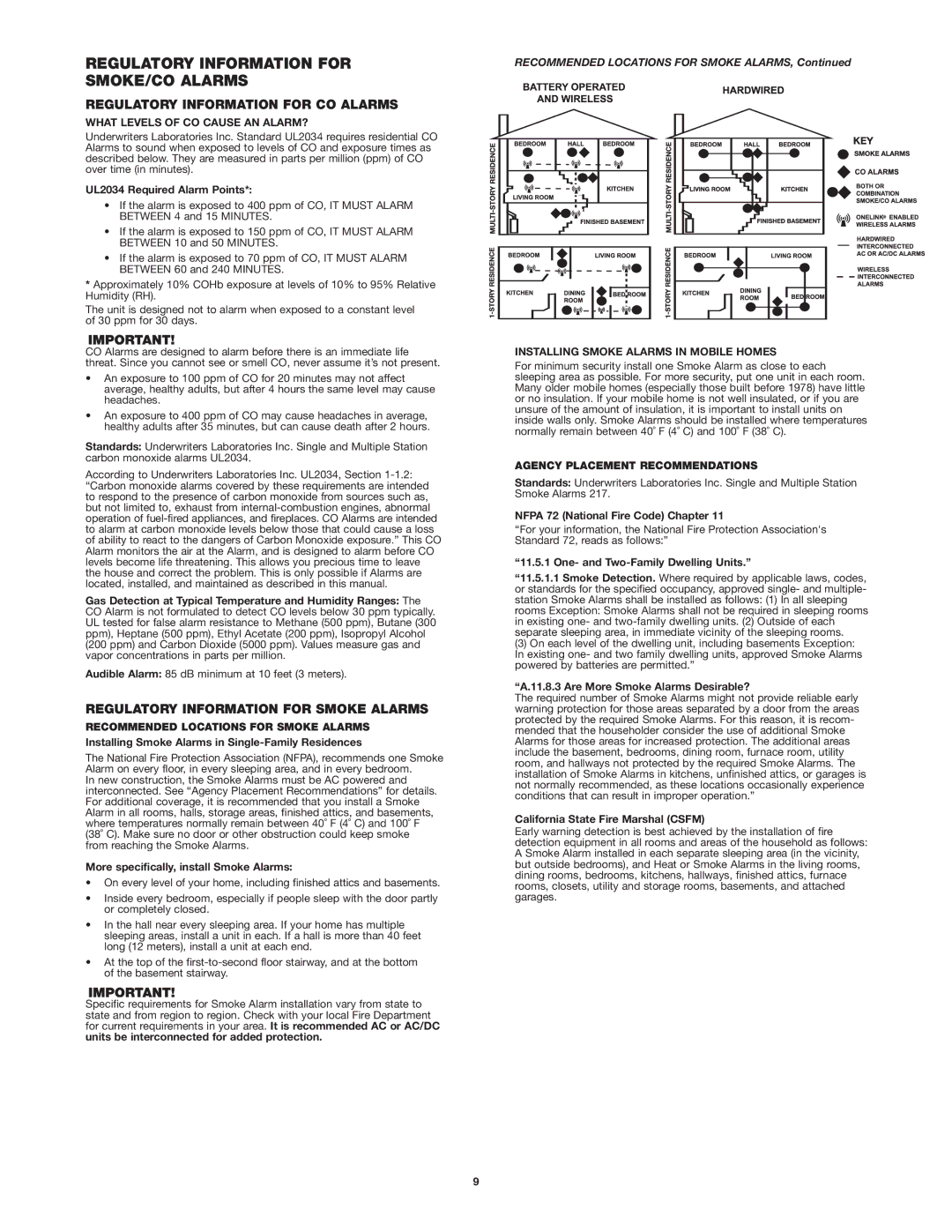
REGULATORY INFORMATION FOR
SMOKE/CO ALARMS
REGULATORY INFORMATION FOR CO ALARMS
WHAT LEVELS OF CO CAUSE AN ALARM?
Underwriters Laboratories Inc. Standard UL2034 requires residential CO Alarms to sound when exposed to levels of CO and exposure times as described below. They are measured in parts per million (ppm) of CO over time (in minutes).
UL2034 Required Alarm Points*:
•If the alarm is exposed to 400 ppm of CO, IT MUST ALARM BETWEEN 4 and 15 MINUTES.
•If the alarm is exposed to 150 ppm of CO, IT MUST ALARM BETWEEN 10 and 50 MINUTES.
•If the alarm is exposed to 70 ppm of CO, IT MUST ALARM BETWEEN 60 and 240 MINUTES.
*Approximately 10% COHb exposure at levels of 10% to 95% Relative Humidity (RH).
The unit is designed not to alarm when exposed to a constant level of 30 ppm for 30 days.
CO Alarms are designed to alarm before there is an immediate life threat. Since you cannot see or smell CO, never assume it’s not present.
•An exposure to 100 ppm of CO for 20 minutes may not affect average, healthy adults, but after 4 hours the same level may cause headaches.
•An exposure to 400 ppm of CO may cause headaches in average, healthy adults after 35 minutes, but can cause death after 2 hours.
Standards: Underwriters Laboratories Inc. Single and Multiple Station carbon monoxide alarms UL2034.
According to Underwriters Laboratories Inc. UL2034, Section
Gas Detection at Typical Temperature and Humidity Ranges: The CO Alarm is not formulated to detect CO levels below 30 ppm typically. UL tested for false alarm resistance to Methane (500 ppm), Butane (300 ppm), Heptane (500 ppm), Ethyl Acetate (200 ppm), Isopropyl Alcohol (200 ppm) and Carbon Dioxide (5000 ppm). Values measure gas and vapor concentrations in parts per million.
Audible Alarm: 85 dB minimum at 10 feet (3 meters).
REGULATORY INFORMATION FOR SMOKE ALARMS
RECOMMENDED LOCATIONS FOR SMOKE ALARMS
Installing Smoke Alarms in Single-Family Residences
The National Fire Protection Association (NFPA), recommends one Smoke Alarm on every floor, in every sleeping area, and in every bedroom.
In new construction, the Smoke Alarms must be AC powered and interconnected. See “Agency Placement Recommendations” for details. For additional coverage, it is recommended that you install a Smoke Alarm in all rooms, halls, storage areas, finished attics, and basements, where temperatures normally remain between 40˚ F (4˚ C) and 100˚ F (38˚ C). Make sure no door or other obstruction could keep smoke from reaching the Smoke Alarms.
More specifically, install Smoke Alarms:
•On every level of your home, including finished attics and basements.
•Inside every bedroom, especially if people sleep with the door partly or completely closed.
•In the hall near every sleeping area. If your home has multiple sleeping areas, install a unit in each. If a hall is more than 40 feet long (12 meters), install a unit at each end.
•At the top of the
Specific requirements for Smoke Alarm installation vary from state to state and from region to region. Check with your local Fire Department for current requirements in your area. It is recommended AC or AC/DC units be interconnected for added protection.
RECOMMENDED LOCATIONS FOR SMOKE ALARMS, Continued
INSTALLING SMOKE ALARMS IN MOBILE HOMES
For minimum security install one Smoke Alarm as close to each sleeping area as possible. For more security, put one unit in each room. Many older mobile homes (especially those built before 1978) have little or no insulation. If your mobile home is not well insulated, or if you are unsure of the amount of insulation, it is important to install units on inside walls only. Smoke Alarms should be installed where temperatures normally remain between 40˚ F (4˚ C) and 100˚ F (38˚ C).
AGENCY PLACEMENT RECOMMENDATIONS
Standards: Underwriters Laboratories Inc. Single and Multiple Station Smoke Alarms 217.
NFPA 72 (National Fire Code) Chapter 11
“For your information, the National Fire Protection Association's Standard 72, reads as follows:”
“11.5.1 One- and Two-Family Dwelling Units.”
“11.5.1.1 Smoke Detection. Where required by applicable laws, codes, or standards for the specified occupancy, approved single- and multiple- station Smoke Alarms shall be installed as follows: (1) In all sleeping rooms Exception: Smoke Alarms shall not be required in sleeping rooms in existing one- and
(3)On each level of the dwelling unit, including basements Exception: In existing one- and two family dwelling units, approved Smoke Alarms powered by batteries are permitted.”
“A.11.8.3 Are More Smoke Alarms Desirable?
The required number of Smoke Alarms might not provide reliable early warning protection for those areas separated by a door from the areas protected by the required Smoke Alarms. For this reason, it is recom- mended that the householder consider the use of additional Smoke Alarms for those areas for increased protection. The additional areas include the basement, bedrooms, dining room, furnace room, utility room, and hallways not protected by the required Smoke Alarms. The installation of Smoke Alarms in kitchens, unfinished attics, or garages is not normally recommended, as these locations occasionally experience conditions that can result in improper operation.”
California State Fire Marshal (CSFM)
Early warning detection is best achieved by the installation of fire detection equipment in all rooms and areas of the household as follows: A Smoke Alarm installed in each separate sleeping area (in the vicinity, but outside bedrooms), and Heat or Smoke Alarms in the living rooms, dining rooms, bedrooms, kitchens, hallways, finished attics, furnace rooms, closets, utility and storage rooms, basements, and attached garages.
9
